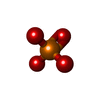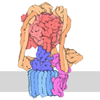[English] 日本語
 Yorodumi
Yorodumi- PDB-9io5: Cryo-EM structure of G1-ATPase dimer from Mycoplasma mobile glidi... -
+ Open data
Open data
- Basic information
Basic information
| Entry | Database: PDB / ID: 9io5 | |||||||||||||||
|---|---|---|---|---|---|---|---|---|---|---|---|---|---|---|---|---|
| Title | Cryo-EM structure of G1-ATPase dimer from Mycoplasma mobile gliding machinery | |||||||||||||||
 Components Components |
| |||||||||||||||
 Keywords Keywords | HYDROLASE / ATPase / Complex / kinase / Ring | |||||||||||||||
| Function / homology |  Function and homology information Function and homology informationH+-transporting two-sector ATPase / phosphoglycerate kinase / phosphoglycerate kinase activity / proton-transporting ATP synthase complex / proton-transporting ATP synthase activity, rotational mechanism / glycolytic process / gluconeogenesis / ADP binding / hydrolase activity / ATP binding / cytosol Similarity search - Function | |||||||||||||||
| Biological species |  Mycoplasma mobile 163K (bacteria) Mycoplasma mobile 163K (bacteria) | |||||||||||||||
| Method | ELECTRON MICROSCOPY / single particle reconstruction / cryo EM / Resolution: 3.2 Å | |||||||||||||||
 Authors Authors | Toyonaga, T. / Kato, T. / Kawamoto, A. / Miyata, T. / Kawakami, K. / Fujita, J. / Hamaguchi, T. / Namba, K. / Miyata, M. | |||||||||||||||
| Funding support |  Japan, 4items Japan, 4items
| |||||||||||||||
 Citation Citation |  Journal: Sci Adv / Year: 2025 Journal: Sci Adv / Year: 2025Title: Dimeric assembly of F-like ATPase for the gliding motility of . Authors: Takuma Toyonaga / Takayuki Kato / Akihiro Kawamoto / Tomoko Miyata / Keisuke Kawakami / Junso Fujita / Tasuku Hamaguchi / Keiichi Namba / Makoto Miyata /  Abstract: Rotary ATPases, including FF-, VV-, and AA-ATPases, are molecular motors that exhibit rotational movements for energy conversion. In the gliding bacterium, , a dimeric F-like ATPase forms a chain ...Rotary ATPases, including FF-, VV-, and AA-ATPases, are molecular motors that exhibit rotational movements for energy conversion. In the gliding bacterium, , a dimeric F-like ATPase forms a chain structure within the cell, which is proposed to drive the gliding motility. However, the mechanisms of force generation and transmission remain unclear. We determined the electron cryomicroscopy (cryo-EM) structure of the dimeric F-like ATPase complex. The structure revealed an assembly distinct from those of dimeric FF-ATPases. The F-like ATPase unit associated by two subunits GliD and GliE was named G-ATPase as an R domain of rotary ATPases. G-β subunit, a homolog of the F-ATPase catalytic subunit, exhibited a specific N-terminal region that incorporates the glycolytic enzyme, phosphoglycerate kinase into the complex. Structural features of the ATPase displayed strong similarities to F-ATPase, suggesting a rotation based on the rotary catalytic mechanism. Overall, the cryo-EM structure provides insights into the mechanism through which G-ATPase drives the gliding motility. | |||||||||||||||
| History |
|
- Structure visualization
Structure visualization
| Structure viewer | Molecule:  Molmil Molmil Jmol/JSmol Jmol/JSmol |
|---|
- Downloads & links
Downloads & links
- Download
Download
| PDBx/mmCIF format |  9io5.cif.gz 9io5.cif.gz | 1.5 MB | Display |  PDBx/mmCIF format PDBx/mmCIF format |
|---|---|---|---|---|
| PDB format |  pdb9io5.ent.gz pdb9io5.ent.gz | 1.2 MB | Display |  PDB format PDB format |
| PDBx/mmJSON format |  9io5.json.gz 9io5.json.gz | Tree view |  PDBx/mmJSON format PDBx/mmJSON format | |
| Others |  Other downloads Other downloads |
-Validation report
| Summary document |  9io5_validation.pdf.gz 9io5_validation.pdf.gz | 2.1 MB | Display |  wwPDB validaton report wwPDB validaton report |
|---|---|---|---|---|
| Full document |  9io5_full_validation.pdf.gz 9io5_full_validation.pdf.gz | 2.1 MB | Display | |
| Data in XML |  9io5_validation.xml.gz 9io5_validation.xml.gz | 222.6 KB | Display | |
| Data in CIF |  9io5_validation.cif.gz 9io5_validation.cif.gz | 352.6 KB | Display | |
| Arichive directory |  https://data.pdbj.org/pub/pdb/validation_reports/io/9io5 https://data.pdbj.org/pub/pdb/validation_reports/io/9io5 ftp://data.pdbj.org/pub/pdb/validation_reports/io/9io5 ftp://data.pdbj.org/pub/pdb/validation_reports/io/9io5 | HTTPS FTP |
-Related structure data
| Related structure data |  60718MC M: map data used to model this data C: citing same article ( |
|---|---|
| Similar structure data | Similarity search - Function & homology  F&H Search F&H Search |
- Links
Links
- Assembly
Assembly
| Deposited unit | 
|
|---|---|
| 1 |
|
- Components
Components
-G1-ATPase subunit ... , 5 types, 21 molecules ABCHIJDEFKLMGNRSTUVWX
| #1: Protein | Mass: 88510.383 Da / Num. of mol.: 6 / Source method: isolated from a natural source / Source: (natural)  Mycoplasma mobile 163K (bacteria) / Strain: P476R gli521 Mycoplasma mobile 163K (bacteria) / Strain: P476R gli521References: UniProt: Q6KIC3, H+-transporting two-sector ATPase #2: Protein | Mass: 58794.668 Da / Num. of mol.: 6 / Source method: isolated from a natural source / Source: (natural)  Mycoplasma mobile 163K (bacteria) / Strain: P476R gli521 Mycoplasma mobile 163K (bacteria) / Strain: P476R gli521References: UniProt: Q6KIC4, H+-transporting two-sector ATPase #3: Protein | Mass: 39810.602 Da / Num. of mol.: 2 / Source method: isolated from a natural source / Source: (natural)  Mycoplasma mobile 163K (bacteria) / Strain: P476R gli521 / References: UniProt: Q6KIC7 Mycoplasma mobile 163K (bacteria) / Strain: P476R gli521 / References: UniProt: Q6KIC7#5: Protein | Mass: 33753.953 Da / Num. of mol.: 6 / Source method: isolated from a natural source / Source: (natural)  Mycoplasma mobile 163K (bacteria) / Strain: P476R gli521 / References: UniProt: Q6KIC8 Mycoplasma mobile 163K (bacteria) / Strain: P476R gli521 / References: UniProt: Q6KIC8#6: Protein | | Mass: 13264.168 Da / Num. of mol.: 1 / Source method: isolated from a natural source / Source: (natural)  Mycoplasma mobile 163K (bacteria) / Strain: P476R gli521 / References: UniProt: Q6KHS6 Mycoplasma mobile 163K (bacteria) / Strain: P476R gli521 / References: UniProt: Q6KHS6 |
|---|
-Protein , 1 types, 3 molecules OPQ
| #4: Protein | Mass: 56680.750 Da / Num. of mol.: 3 / Source method: isolated from a natural source / Source: (natural)  Mycoplasma mobile 163K (bacteria) / Strain: P476R gli521 / References: UniProt: Q6KHJ1, phosphoglycerate kinase Mycoplasma mobile 163K (bacteria) / Strain: P476R gli521 / References: UniProt: Q6KHJ1, phosphoglycerate kinase |
|---|
-Protein/peptide , 2 types, 2 molecules YZ
| #7: Protein/peptide | Mass: 1124.378 Da / Num. of mol.: 1 / Source method: isolated from a natural source / Source: (natural)  Mycoplasma mobile 163K (bacteria) / Strain: P476R gli521 Mycoplasma mobile 163K (bacteria) / Strain: P476R gli521 |
|---|---|
| #8: Protein/peptide | Mass: 783.958 Da / Num. of mol.: 1 / Source method: isolated from a natural source / Source: (natural)  Mycoplasma mobile 163K (bacteria) / Strain: P476R gli521 Mycoplasma mobile 163K (bacteria) / Strain: P476R gli521 |
-Non-polymers , 4 types, 22 molecules 






| #9: Chemical | ChemComp-ATP / #10: Chemical | ChemComp-MG / #11: Chemical | #12: Chemical | |
|---|
-Details
| Has ligand of interest | Y |
|---|---|
| Has protein modification | N |
-Experimental details
-Experiment
| Experiment | Method: ELECTRON MICROSCOPY |
|---|---|
| EM experiment | Aggregation state: PARTICLE / 3D reconstruction method: single particle reconstruction |
- Sample preparation
Sample preparation
| Component | Name: G1-ATPase dimer from Mycoplasma mobile gliding machinery Type: COMPLEX / Entity ID: #1-#8 / Source: NATURAL | |||||||||||||||||||||||||||||||||||
|---|---|---|---|---|---|---|---|---|---|---|---|---|---|---|---|---|---|---|---|---|---|---|---|---|---|---|---|---|---|---|---|---|---|---|---|---|
| Source (natural) | Organism:  Mycoplasma mobile 163K (bacteria) / Strain: P476R gli521 Mycoplasma mobile 163K (bacteria) / Strain: P476R gli521 | |||||||||||||||||||||||||||||||||||
| Buffer solution | pH: 7.3 | |||||||||||||||||||||||||||||||||||
| Buffer component |
| |||||||||||||||||||||||||||||||||||
| Specimen | Conc.: 1 mg/ml / Embedding applied: NO / Shadowing applied: NO / Staining applied: NO / Vitrification applied: YES | |||||||||||||||||||||||||||||||||||
| Specimen support | Details: Epoxidized graphene grid (EG-grid) was used. / Grid material: GOLD / Grid mesh size: 200 divisions/in. / Grid type: Quantifoil R1.2/1.3 | |||||||||||||||||||||||||||||||||||
| Vitrification | Instrument: FEI VITROBOT MARK IV / Cryogen name: ETHANE / Humidity: 100 % / Chamber temperature: 277 K |
- Electron microscopy imaging
Electron microscopy imaging
| Microscopy | Model: JEOL CRYO ARM 300 |
|---|---|
| Electron gun | Electron source:  FIELD EMISSION GUN / Accelerating voltage: 300 kV / Illumination mode: FLOOD BEAM FIELD EMISSION GUN / Accelerating voltage: 300 kV / Illumination mode: FLOOD BEAM |
| Electron lens | Mode: BRIGHT FIELD / Nominal magnification: 60000 X / Nominal defocus max: 1800 nm / Nominal defocus min: 800 nm / Cs: 2.7 mm / C2 aperture diameter: 50 µm |
| Specimen holder | Cryogen: NITROGEN / Specimen holder model: JEOL CRYOSPECPORTER |
| Image recording | Average exposure time: 3.3 sec. / Electron dose: 80 e/Å2 / Film or detector model: GATAN K3 (6k x 4k) / Num. of grids imaged: 1 / Num. of real images: 7350 |
| EM imaging optics | Energyfilter name: In-column Omega Filter / Energyfilter slit width: 20 eV |
- Processing
Processing
| EM software |
| |||||||||||||||||||||||||||||||||||||||||||||||||||||||
|---|---|---|---|---|---|---|---|---|---|---|---|---|---|---|---|---|---|---|---|---|---|---|---|---|---|---|---|---|---|---|---|---|---|---|---|---|---|---|---|---|---|---|---|---|---|---|---|---|---|---|---|---|---|---|---|---|
| CTF correction | Type: PHASE FLIPPING AND AMPLITUDE CORRECTION | |||||||||||||||||||||||||||||||||||||||||||||||||||||||
| Particle selection | Num. of particles selected: 633820 | |||||||||||||||||||||||||||||||||||||||||||||||||||||||
| Symmetry | Point symmetry: C1 (asymmetric) | |||||||||||||||||||||||||||||||||||||||||||||||||||||||
| 3D reconstruction | Resolution: 3.2 Å / Resolution method: FSC 0.143 CUT-OFF / Num. of particles: 142490 / Algorithm: FOURIER SPACE / Symmetry type: POINT |
 Movie
Movie Controller
Controller


 PDBj
PDBj







